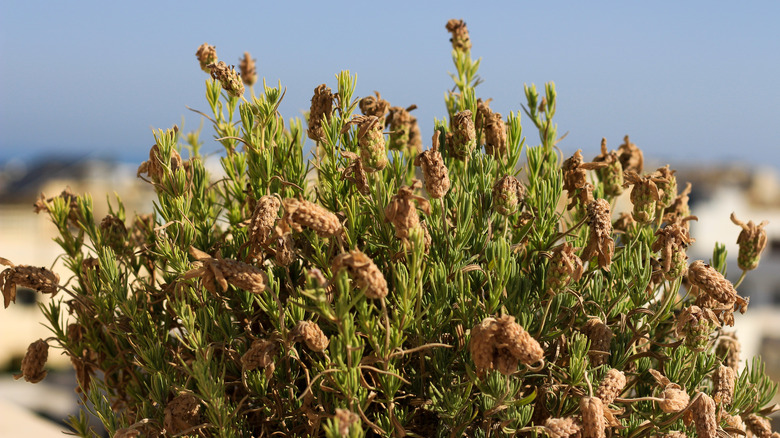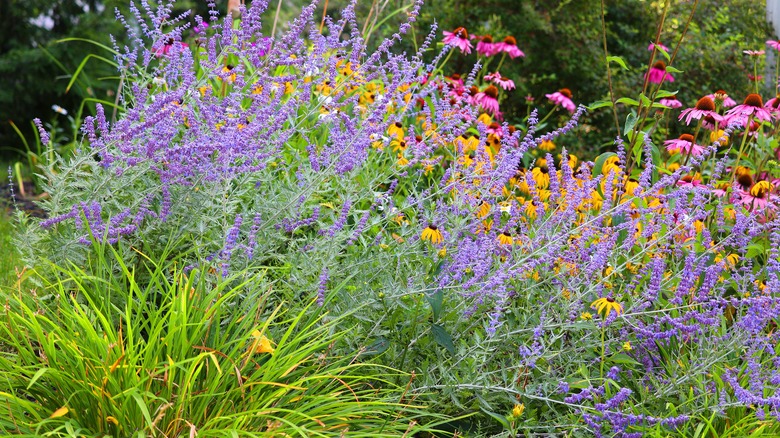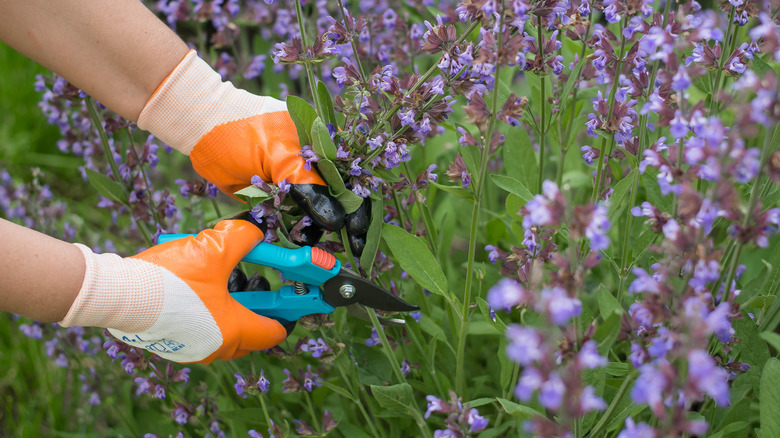Is Humidity The Silent Killer Of Lavender? (And What Lookalike Can Take The Heat)
We may receive a commission on purchases made from links.
Few plants beat the herbaceous scent, cottage garden vibes, and pollinator attraction of a garden bed or big container planted out with lavender. This member of the mint family is a notoriously finicky plant, especially for those living in more humid climates. One of the biggest mistakes to avoid when growing lavender is not taking into consideration the plant's Mediterranean origins. The strong smelling shrub is native to southern Europe, where it can be found happily putting down roots in rocky landscapes with no shade and dry, barely fertile topsoil. It's considered highly drought tolerant for exactly this reason.
In American home gardens, lavender needs long periods of full sun and well-draining, alkaline soil. Overly wet dirt and high humidity lead to fungal infections, root rot, and moisture-loving foliage diseases like leaf spot and leaf blight. Using organic mulches is a no-no for this plant since they raise humidity levels to unbearable levels (for the lavender, at least) — it's one reason you should think twice before using fallen pine needles as mulch. Balancing irrigation needs is a must if you hope to take cuttings for decorative or fragrance purposes. Too little or too much soil humidity, the result of under or overwatering, leads to weak shoot growth.
It's far from surprising, then, that English lavender (Lavandula angustifolia), in particular, fails to thrive in humid climates like those of, for example, Florida, North Carolina, Kentucky, Virginia, and Missouri. In saying that, there are hybrids created for greater humidity tolerance — 'Goodwin Creek Gray' Lavandula dentata x L. lanata and 'Phenomenal' Lavandula x intermedia being two of them. Spanish lavender (Lavandula stoechas) is another moderately humidity tolerant variety. However, if you want to skip the humidity harm risk altogether, it could be better to consider a hardier lavender lookalike. Enter Russian sage.
Why Russian sage makes a great lavender alternative in humid climes
Like lavender, Russian sage (variously called Perovskia atriplicifolia or the more contemporary Salvia yangii in horticultural circles) boasts attractive silvery foliage and long blue to purple-hued flower stems with a strong, pleasant scent. The plant comes neither from Russia nor is it related to sage. It is, in fact, a native of high altitude locales in Southwest and Central Asia. This mint relative reaches 5 feet in height with a little less spread, blooms through the summer (great for pollinators), and pesky mammalian herbivores like deer and rabbits avoid it. Russian sage is such a beloved plant in the U.S. that the Perennial Plant Association named it Perennial Plant of the Year in 1995.
While it's far from a bog plant — like lavender, Russian sage roots will rot if the soil it's burrowing through stays continually damp — it does tolerate or even prefer humid conditions more than its counterpart. Though the plant loves the sun, it also thrives in partial shade, making it more humid-hardy than lavender, which recoils under even a drop of shade. Russian sage plants also need heavy watering in their first year or so of life to establish a sturdy root system. Just watch for powdery mildew during particularly rainy and damp periods. It does well in Zones 5 to 9 as opposed to a Zone 8 cut-off (at a push) for common English lavender. It even does well in humid, subtropical Alabama, for example.
Buying, planting, and caring for Russian sage
Possibly the only downside to this plant is that Russian sage has the tendency to spread vigorously by seeds and runners if left to its own devices, so consider carefully where you plant your seedlings — for example, in containers instead of your garden beds. A 3-inch pot of regular ol' Russian sage costs almost $7 at American Meadows and ships in March. Recommended cultivars include compact and non-floppy 'Blue Baby Jean' — a bare-root plant sells for around $25 at Spring Hill Nurseries. Perovskia 'Blue Spire', sold in 5 inch pots for about $12 by High Country Gardens, boasts deep blue-purple flowers, while Perovskia 'Longin', a 3.25 inch pot is around $5 from The Growers Exchange, features upright growth and larger leaves. Buy 'Blue Steel' seeds on Amazon for under $30; the variety has silver stems and violet-blue flowers.
Plants obtained, how to successfully grow Russian sage plants? If your garden soil drains well, pop either directly into your beds. Alternatively, grow the plant in a raised bed filled with a loose medium or a container with lots of drainage holes. Good drainage is the key to Russian sage's humidity resistance, especially in places with rainy winters. Russian sage will grow large if it's well irrigated, so keep that in mind when deciding on your placement or planter size. Mulch Russian sage in winter to protect plants from cold temperatures, and prune mature plants in late fall or early winter to stop them wilting.


